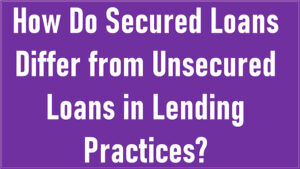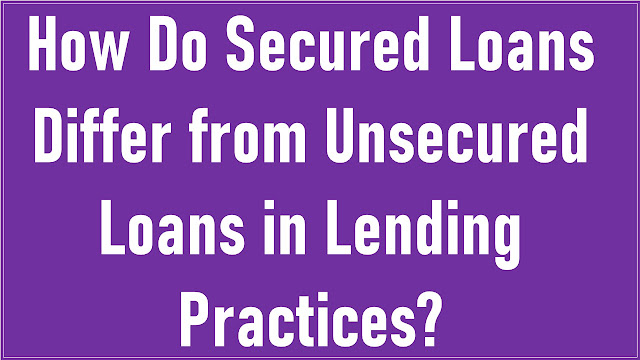
Introduction.
In this article, I’ll explore a fundamental aspect of lending practices: the crucial distinction between secured loans and unsecured loans. When individuals seek financial assistance, they often encounter these two primary categories, each with its unique set of characteristics and implications. Understanding the disparities between secured and unsecured loans is essential, as it directly influences borrowers’ options, obligations, and the potential risks they assume.
Secured loans, backed by collateral, provide lenders with a safety net, offering relatively lower interest rates and higher borrowing limits. In contrast, unsecured loans, devoid of collateral, rely on the borrower’s creditworthiness, resulting in different eligibility criteria and interest rates. Delving deeper into this comparison, we will unravel the nuances of these lending practices, empowering you to make informed financial decisions that suit your specific needs and circumstances.
- Definition of secured and unsecured loans.
- Collateral requirement for secured loans.
- Risk assessment in lending for both types.
- Interest rates and terms for each loan.
- Consequences of default on secured vs. unsecured loans.
- Choosing the right loan for your financial needs.
Definition of Secured and Unsecured Loans.
Secured loans and unsecured loans are two fundamental types of borrowing in the world of lending. Secured loans are loans that are backed by collateral, which is an asset the borrower provides as security for the loan. This collateral could be real estate, a vehicle, or another valuable possession. In contrast, unsecured loans do not require collateral.
Instead, they are granted based on the borrower’s creditworthiness and promise to repay. These loans are typically riskier for lenders, as they have no tangible assets to claim in case of default. Secured loans tend to have lower interest rates due to the reduced risk for the lender, while unsecured loans usually come with higher interest rates to compensate for the increased risk.
Secured loans are commonly used for significant purchases like homes and cars, where the purchased item itself serves as collateral. Unsecured loans, on the other hand, are often used for personal expenses, debt consolidation, or smaller-scale investments. Understanding the distinction between these two types of loans is essential for borrowers looking to make informed financial decisions and for lenders to determine the level of risk associated with a loan application.
Collateral Requirement for Secured Loans.
Secured loans require collateral, which is an asset of value provided by the borrower to secure the loan. This collateral acts as a safety net for the lender in case the borrower defaults on the loan. The specific collateral can vary widely depending on the type of loan, but it is usually an asset with a tangible value, such as real estate, a vehicle, or a savings account. In the event of a default, the lender has the legal right to take possession of the collateral and sell it to recover the outstanding debt.
The type and value of collateral required for secured loans are typically determined by the lender, and the borrower must meet these requirements to secure the loan. If the borrower defaults on the loan, the lender will follow a legal process to take ownership of the collateral. This serves as a significant incentive for borrowers to make timely payments and fulfill their loan obligations.
Risk Assessment in Lending for Both Types.
Lenders assess risk differently when considering applications for secured and unsecured loans. In secured loans, the primary risk assessment focuses on the value and quality of the collateral. Lenders look at the current market value of the asset, its condition, and whether it can easily be sold in case of default. The borrower’s creditworthiness is still a factor, but it may carry less weight since the collateral provides a substantial level of security.
For unsecured loans, risk assessment primarily revolves around the borrower’s creditworthiness. Lenders evaluate factors such as credit score, income stability, employment history, and debt-to-income ratio. Since there is no collateral to fall back on, lenders need to be more confident in the borrower’s ability to repay the loan based on their financial history and stability. As a result, unsecured loans are generally more difficult to obtain for individuals with lower credit scores or unstable financial backgrounds.
These first three outlines provide a foundational understanding of secured and unsecured loans, the collateral requirements for secured loans, and the distinct risk assessment methods for each type of loan. In the context of “How Do Secured Loans Differ from Unsecured Loans in Lending Practices?” this information serves as a critical starting point for comprehending the key differences between these loan types.
Interest Rates and Terms for Each Loan.
Interest rates and terms vary significantly between secured and unsecured loans. Secured loans typically come with lower interest rates compared to unsecured loans. The reason is that secured loans are less risky for lenders due to the presence of collateral. This reduced risk allows lenders to offer borrowers more favorable terms, such as longer repayment periods and lower annual percentage rates (APRs).
Borrowers often use secured loans for substantial investments like buying a house or financing a business, taking advantage of these attractive terms. In contrast, unsecured loans have higher interest rates. Since there is no collateral to secure the loan, lenders charge higher interest to compensate for the increased risk.
Unsecured loans often have shorter repayment terms and higher monthly payments. These loans are commonly used for personal expenses, debt consolidation, or smaller-scale investments. The shorter terms and higher interest rates reflect the lender’s desire to mitigate the risk associated with lending without collateral.
Consequences of Default on Secured vs. Unsecured Loans.
Defaulting on a loan has significant consequences, but the repercussions differ for secured and unsecured loans. In the case of a secured loan, if the borrower fails to make payments and ultimately defaults, the lender has the legal right to take possession of the collateral. They can then sell the collateral to recover the outstanding debt. However, if the sale of the collateral doesn’t cover the entire debt, the borrower may still be responsible for the remaining balance.
For unsecured loans, the consequences of default are primarily financial and credit-related. The lender can pursue the unpaid debt through collection efforts, which may involve working with collection agencies or taking legal action. This can lead to a damaged credit score, making it more challenging for the borrower to secure loans or credit in the future. Additionally, unsecured loan defaults can result in legal actions and court judgments, potentially leading to wage garnishment or asset seizure.
Understanding these consequences is essential for borrowers to realize the gravity of loan default and to make informed choices regarding their financial commitments.
Choosing the Right Loan for Your Financial Needs.
Selecting the right type of loan is crucial for individuals and businesses. When deciding between secured and unsecured loans, borrowers should consider their specific financial needs, risk tolerance, and ability to meet the terms of the loan. Secured loans are suitable for larger investments and projects that require extended repayment periods and lower interest rates.
They are ideal for borrowers who have valuable assets to use as collateral and are confident in their ability to meet the repayment terms.
On the other hand, unsecured loans are more appropriate for short-term, smaller-scale financial needs or when borrowers don’t have substantial assets to offer as collateral. They are an option for individuals with good credit and stable financial situations who can manage higher interest rates and shorter repayment terms.
Conclusion.
I hope this exploration of secured and unsecured loans has shed light on the critical distinctions in lending practices. In conclusion, secured loans offer lenders a higher level of assurance, as they are backed by collateral, typically resulting in lower interest rates and more extended repayment terms. This can be advantageous for borrowers seeking substantial amounts of money and those with weaker credit scores, as it makes borrowing more accessible. However, the downside lies in the risk of losing the collateral if payments are not met.
Conversely, unsecured loans do not require collateral, making them more accessible to borrowers, particularly those with strong credit histories. Yet, this convenience often comes at the price of higher interest rates and shorter repayment periods. When deciding between the two, borrowers must consider their financial situation and the nature of their needs, while lenders must evaluate risk and borrower credibility. In the end, both secured and unsecured loans have their merits and drawbacks, allowing borrowers to choose the option that aligns best with their financial objectives and capacity.
